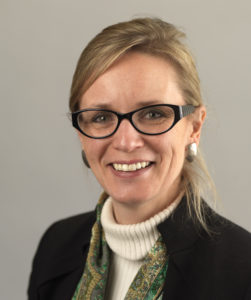Earlier this month, Cambridge University Press and the University of California announced a new Read & Publish (R&P) agreement. This announcement was striking for several reasons. First, it is likely the largest R&P agreement to be signed in North America. Second, it follows close on the heels of the California decision to walk away from its negotiations with Elsevier following efforts that failed to reach a Publish & Read agreement. I was privileged to have the chance to interview two executives for Academic Publishing at Cambridge: Mandy Hill, Managing Director, and Chris Bennett, Global Sales Director, about this new agreement.

Congratulations on striking this deal in this period of upheaval. What are you excited about in this new agreement? What is new?

Mandy Hill (MH): Cambridge University Press and the University of California have just agreed to a transformational “Read and Publish” deal in principle. Under its terms, 60% of California’s overall spend on Cambridge journals will be used to support unlimited open access (OA) publishing; the remainder, assigned to accessing content that is not OA. Over time, the publishing portion is designed to grow whilst the “read” part diminishes gradually. This is the sixth and latest such agreement to be made by Cambridge, as part of its commitment, with its parent university, to a real and sustainable transition to an open research world.
Chris Bennett (CB): We’re especially excited that this agreement is one of the first of scale outside Europe, and with the university system that represents the largest portion of our journals publishing output in in the US and that is actively making changes to better enable public access to important research. It is no exaggeration that it is changing attitudes to the viability of such deals amongst other North American libraries and consortia. The agreement itself has the most developed model of those yet signed by Cambridge, in that it reflects the reality of Cambridge’s list (significant “non-research” HSS content) whilst being designed to effect the greatest transformation possible during its term.
Do the researchers pay any of the publication fees, whether through grant-funded APCs or otherwise? Or are all publishing costs paid for by the university libraries?
CB: Existing APC spend by California researchers on Cambridge journals has been factored into the deal price, whilst the majority of publishing revenue is transferred directly from existing collection spend; however, we expect that the California Digital Library (CDL) will want to change the publishing processes of its ten campuses in order to track and manage this in one place. Cambridge has committed to working jointly with them on a new workflow accordingly.
Does the deal include your fully-OA journals or just hybrids? How will the model allocate money to fully-OA journals?

CB: All Cambridge journals in the collection are included, whether fully Gold, hybrid or with no OA (as yet, therefore covered in the Read portion at the outset of the deal with transformation expected once these titles accept OA publishing). Read and Publish deals are a stepping stone to transition our entire journals program to sustainable OA and therefore it is, we believe, important to include all journals in the deals. We do not see authors paying separate APCs being the dominant business model for the future, which is one reason for factoring in the existing publishing spend on them from California.
Many in the community are interested in why it is that Wiley was able to make a deal with Germany, and now Cambridge with California, when Elsevier has fallen flat with both. Without asking you to speak about any of your competitors specifically, can I ask you to distinguish what is different about Cambridge that makes this deal feasible?
MH: Our commitment to open research stems from being part of a leading research university. This means we are able to take a long term view and plan a roadmap for transition that we believe works for us and our customers. We’re determined to achieve these aims but understand that it is a challenge of a different order of magnitude for larger, commercial and STM-based publishers.
We believe that an open research future will drive improved research outcomes globally, that all subjects can benefit from such an approach, and that we need to find sustainable models to support it. However, we also recognize that universities do not necessarily have more money to fund this model and in fact we need to be addressing libraries’ cost concerns.
Given that you have not seen a major price increase in reaching a transformative agreement with California, do you see this deal as a loss-leader or is it a model that you are happy to strike with any group of libraries around the globe?
CB: This deal is not a loss leader in terms of translating our current spend sustainably to projected levels of publishing during the deal period. We’re looking for a certain level of equivalent spend per article to cover our costs with a modest margin, and the deal achieves that.
What this does not do, however, is compensate fully for the potential in lost revenue as more of our program shifts to an open model. In a shift to pay-to-publish from pay-to-read we anticipate that there will be a smaller customer base (the more research intensive universities for example). So if those customers who want to convert can’t pay much more and there are fewer customers, it stands to reason that we will see a like-for-like revenue decline globally. This is a problem for us as we don’t have huge profit margins to play with but we are confident that we can not only make this work through this short term transition, but find ways to grow again from this new base.
We are grateful to partners like CDL who are happy to work with us through this transition and understand the context we are working in. The same model would not work with every library in every market, owing to the very different levels of spend and publishing which have developed over many years. That’s one of the challenges that we would like to work with our library partners to overcome in a move to OA that ultimately benefits the scholarly ecosystem as a whole. CDL has been a particularly transparent and altruistic partner in this respect, and we hope that other library networks will follow suit.
Does your deal with California differ from your deal in the UK with Jisc? Or your Dutch, German, and Swedish deals? If so, how?
CB: This is our sixth R&P deal and for the reasons given above, each of these agreements so far has been tailored to the needs and circumstances of the country concerned. The Dutch deal, signed with the VSNU funder from 2017-19, was the first and anticipated a significant publishing increase at predictable cost, though on an unrestricted basis (one of our guiding principles). This has proved effective, seeing a quadrupling of OA output in its first two years at a price point sustainable for both parties. Both the Swedish (BIBSAM) and two German (DFG and Max Planck) agreements effect a similar level of transferred spend to publishing as CDL does, and are therefore sustainable.
The UK is an example of a much more complex market environment for Cambridge. Jisc does not operate an all-in consortium model for journals with us, and therefore each institution chooses to sign up to the pricing framework agreed. This has always been the case but differentiates this agreement from the others so far. This is complicated further because the proportion of publishing from Cambridge’s home market far exceeds our revenues from it. As a result, our agreement is (for now) APC-based and has four different options for institutions, from business as usual (no OA element) which was wanted by the market, to a commitment to a certain level of publishing at significant discounts on both the APC and collection spend. This mechanism drives the transition effectively across the very different profiles of UK research institutions.
It seems clear that R&P deals can be struck, at least by some publishers, with major consortial groups. We are also starting to see some examples of R&P deals with individual libraries (such as MIT with RSC and Iowa State with DeGruyter). Do you anticipate that Cambridge can sign R&P deals with individual libraries such as these? Or is there a scale of library participation at which R&P becomes possible but not otherwise?
CB: We are keen to work with all our library customers to establish the R&P models that works for them, which has more to do with how effectively we can model out each institution’s publishing growth vs. collection spend. Our Jisc agreement, for example, is per-institution and designed to recognize significant differences between UK universities. Clearly, for the transition to OA via R&P to work overall, we will need to agree terms with the majority of our university partners worldwide, if on terms that work for each – and us – bearing in mind the principle that we will not load a creaking system with substantial additional spend. Consortial scale is obviously helpful in effecting this shift more quickly, but is not a prerequisite for it.
Elsevier has made abundantly clear its view that these transformative deals must require substantial price increases for the academic research universities to cover the anticipated loss of subscription revenue from other sectors. Based on your modeling, what revenue implications do you expect to see from a global flip based on deals like this one?
MH: We are modelling a ten-year horizon which does see significant revenue impact to traditional subscription revenues in the mid-term, followed by recovery through the positive impact of investments in content, technology, further publishing services and brand-new models, which we expect to generate brand-new business. As with any mature industry, we ought all to be prepared to change our approach to enter a new era, and the university press publishing ethos lends itself well to this.
I know you are still at the stage of celebrating this new deal, but looking ahead a few years to an eventual negotiation and renewal, how will you be monitoring the impact of this agreement in anticipation?
CB: Our agreement with CDL states that both parties will be working together closely to improve workflows, review the progress of the new agreement in practice and ensure that it works effectively, for faculty most of all. We are already investing heavily in metadata improvements to give us much better visibility of (for instance) author affiliations, but above all these agreements are partnerships in which the library too must engage positively with its university-based authors, as must we. We have seen from the Dutch deal what success can look like, and obviously we would like this success to continue to be sustainable, so an ongoing and close dialogue is essential.
MH: It is critical to us that any models for the future enable us to maintain our focus on high quality content and it will be interesting to engage with CDL and other key parties over how to sustain this in an open world. Another key aspect to us is the impact of our content. We will be working with CDL to drive usage so that it can inform research and support improving learning outcomes.
Finally, tell me a little bit about where this fits in your broader vision for Cambridge University Press and its transformation into an “Open Research” publisher.
MH: At the start of 2018 we set out a strategic goal to become an Open Research publisher over the next few years because we believe it can support improved global research outcomes. To achieve the full, sustainable transformation that we want, we are working across a number of strategic themes:
- Contributing to a more diverse OA market, by exploring models and projects that will ensure sustainability and quality. Obviously the use of R&P models fits in here, but we have also successfully ‘flipped’ a number of subscription journals to Gold OA, and will continue to do so until all of our program is fully open, when it is right for each journal. We believe that quality is just as important in OA and that peer review is a key aspect of this so we have been working on a number of open peer review experiments.
- Increasing the Open Research capabilities we provide to our communities by introducing more openness across the research lifecycle. A major example of this is our recent announcement of the Open Research Platform (including preprints) that we will be launching later this year, initially with a service for the American Political Science Association. We are launching a number of new OA STM journals to support emerging areas of science.
- Extending the accessibility and impact of research by investing in innovative solutions to digital dissemination, collaboration, and services. We created Cambridge Core Share to support sharing of research and have over 300 journals using the service and partnered with Code Ocean to increase reproducibility through code sharing. We are also signatories of TOP and are actively implementing open data policies
- Making it easier and more efficient to publish or partner with us in the Open space. As the Outsell report highlighted last year ‘no change is not an option’. We know we need to become more efficient in how we do things, to provide an even better author and customer experience, and be seen to be doing this at a fair price. We’ve done a major metadata project in order to be able to support the R&P reporting of authors at an institutional level, have mandated ORCID ids for all our Cambridge owned journals and are working with the societies we publish for to implement ORCID ids where they would like to.
- Reviewing the support we provide to the University of Cambridge, and how in an open world this may be different. We are working much more closely with a number of teams across the University, notably the University Library, and believe this needs to inform our strategic choices. A demonstration of our closer integration was the joint University of Cambridge submission to Plan S, which reflected the views of the University at large, including Cambridge.
There remain a number of unresolved questions about how a fully open world will work.
For example, which article types does it cover? The ‘publish’ part of our deal with CDL is explicitly for research articles only and they want to pay to access the non-research article types (book reviews, editorials commentaries etc). It is not clear to us whether such a distinction will survive the full transformation, but it we do believe that we will need models that support a variety of article types.
We want to make sure that in moving to OA we don’t exclude authors who are not part of institutions with Pay to Publish deals, especially authors in the Global South who don’t have funds to pay APCs: in this era of inclusivity it is vital we don’t create new barriers. This may well mean very different forms of publishing partnership with these institutions and their funders.
We are very aware that whilst R&P deals do provide a viable path to transformation for us, they might not work for all. It is important, we believe, that the transition to OA doesn’t cause the loss of smaller publishers (with less than a small handful of journals) especially where those journals are in HSS areas. We think it is vital for the whole research ecosystem that the services that many of these journals and publishers bring are not lost, so that innovative scholarly publishing is also sustainable and responsible to the communities it serves – into an open future.
Nearly two thirds of the journals we publish are owned by learned societies and we are proud to work with such wonderful organizations that add real value to their communities. We will be working closely with our society partners to support them through this transition.
Discussion
3 Thoughts on "The First Read and Publish Deal with California: An Interview with Cambridge University Press"
RE. “we are launching a number of new OA STM journals to support emerging areas of science”, why is this regarded as necessary?
I would think that as science advances and new fields emerge, it is helpful to start new journals to serve those fields. Very often, having a dedicated outlet to a particular type of research can help form community and solidify the position of a new field. I can remember back when the first bioinformatics and genomics journals were started to serve those communities for example, as the type of work being done wasn’t really a good fit for traditional genetics journals of the time.
Hi, we all look at these issues through the lenses of our particular trade. I look at it from instincts developed while working as a librarian in the trenches for a very long time, and frankly annoyed at the opportunity costs of librarians in negotiating round after round of journal packages.
Anyhow, someone has to pay for new journals titles, assuming there is not a corresponding contraction of other journals. Unless payments shift to grant funding, but then the public is paying. (Unspoken in a lot of this is the burden APCs put on developing countries.)
The proliferation of new journals is helping fuel the pricing crisis for libraries whose budgets have been flat. Moreoever, and at least as important, is that the ability to transmit scientific knowledge inter-generationally is becoming increasingly difficult given the sea of new journals and their articles.
I’d argue that the preprints should be doing the work of disclosing new discoveries within a contracted market of journals now primarily dedicated to providing a review article function that references preprints (with those articles undergoing some mechanism of very rigorous peer scrutiny–maybe the traditional format of peer review will do just fine, but this model is agnostic on that point.). There is of course the problem of peer review for preprints, but I suspect Ginsparg was right in suggesting that there is a self-policing dynamic at play in preprints. (No self-respecting research group will put up trash, or if it does so, it will in short order put up a new and improved version, having staked a claim to priority of research.) To the extent there is not, the societies should play a role in encouraging high standards of preprint publication. They are indeed needed.
Incidentally, I don’t see a whole lot in this two tier overlay model that differs from what has been around since the days of Henry Oldenburg. Old wine, new skins.
These views are elaborated in my preprint now on arXiv, though I’m working on the next iteration after receiving lots of helpful citations and comments. That preprint aspires to be heuristic, full well realizing the model will likely never materialize any time soon. Heuristic in calling for new thinking about how to meet the traditional aims of scientific communication, but in re-configured ways to address what is problematic these days.
I’m as averse as you, in any case, to undue speculation about future publication models.
Am actually almost exclusively interested in the model as it pertains to physics, since the underlying cultures of at least some of its subdisciplines have enabled preprints.
This is all a very big topic and my work on this will probably cease after the next version or two! Too many moving parts to write about, and full time job work as a line librarian places practical constraints on all this.
Am mainly returning nostalgically to the early salad days of theorizing about publishing, back in the early 2000’s and really have no illusions about this or that model succeeding. And most importantly having a lot of fun thinking about this stuff. Have a model helps one think through the issues in a systematic way. Again, it’s a heuristic, and like all heuristics, imperfect.



